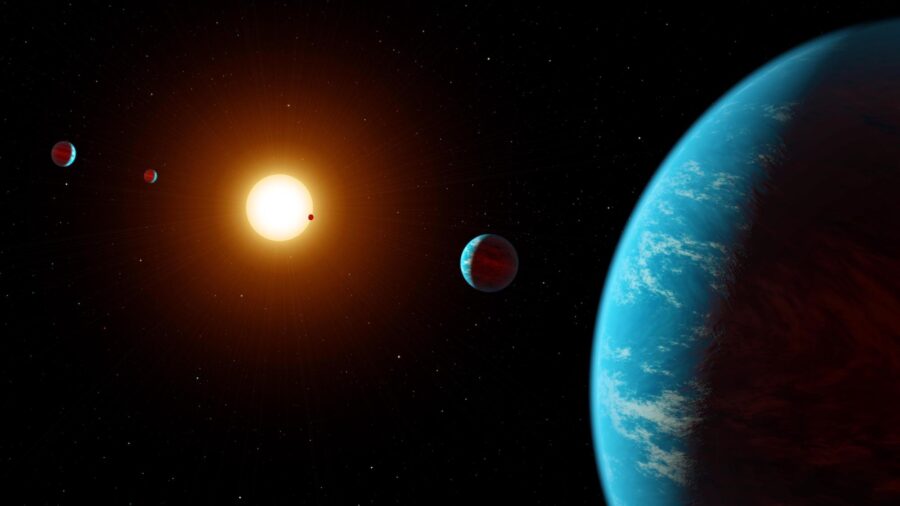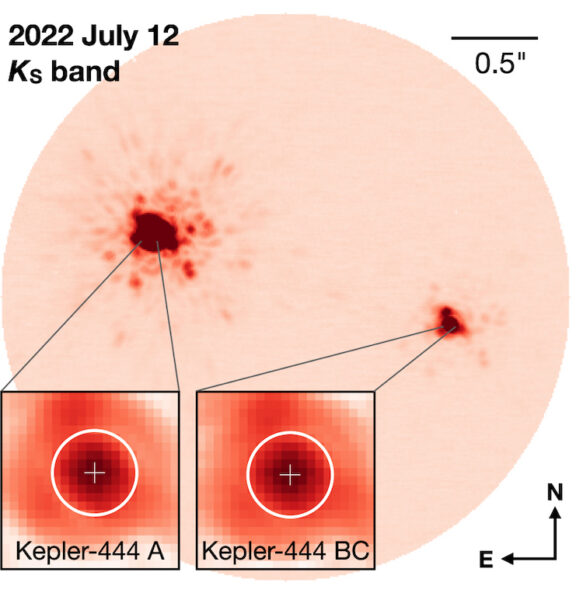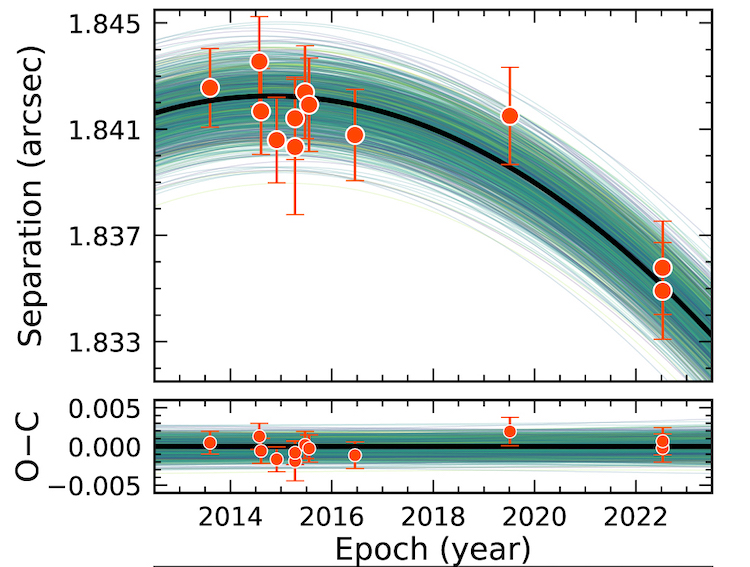Astronomers have taken a closer look at a system containing three stars and five planets and may have solved a mystery around its formation.

NASA / JPL-Caltech
Astronomers have just taken a closer look at an unusual system containing three stars and at least five planets. In doing so they may have solved a mystery around its formation. The system, known as Kepler-444, is also around 11 billion years old, showing that such systems can be stable over a significant fraction of the universe’s current age.
One System, Three Stars, Five Planets
Located 117 light-years away toward the constellation Lyra, the system is centered around the K0 star Kepler-444 A. Then there’s a tight-knit binary pair of M-type stars orbiting it some 66 astronomical units away (known as Kepler-444 BC). A quintet of planets also orbits Kepler-444 A. All five worlds have radii between 0.4 and 0.7 Earth radius, and every one has an orbital period under 10 days.

Adapted from Zhang et al. 2023
A team of astronomers led by Zhoujian Zhang (University of California, Santa Cruz) recently set about measuring the properties of the crowded system more precisely in several different ways. They used the High Resolution Spectrograph of the Hobby-Eberly Telescope at the McDonald Observatory in Texas to measure Kepler-444 A’s radial velocity. The star’s speed changes as it is pulled around by the other objects in the system. Zhang’s team also measured the relative radial velocities between the binary pair and the central star using the High Resolution Echelle Spectrometer at the W. M. Keck Observatory in Hawaii.
The gravitational pull of its companions causes Kepler-444 A to follow a wiggling path across the night sky. Measuring this changing position is known as astrometry. Zhang’s team conducted astrometric measurements of Kepler-444 A using Keck’s near-infrared imager (NIRC2).
Expanding Planet-Forming Potential
Putting all these pieces of the puzzle together, the team arrived at a deeper understanding of the Kepler-444 system and its history. Previous measurements of the system suggested that the binary swings in to within 5 astronomical units of Kepler-444 A. That would have truncated Kepler-444 A’s protoplanetary disk, severely depleting the amount of planet-forming material available. It wasn’t clear how five rocky planets could have formed there.

Adapted from Zhang et al. 2023
Now, based on their new measurements, Zhang’s team conclude that the Kepler-444 BC binary only gets within 23 astronomical units of Kepler-444 A. This wider separation would have led to a larger and more massive protoplanetary disk truncated to 8 astronomical units. The team calculate that there would have been 500 Earth masses’ worth of dust available from which to build planets. That compares to just 4 Earth masses of dust using previous estimates. Suddenly the presence of five planets is less perplexing.
As astronomers gain a greater understanding of exoplanets, it’s becoming clear that there’s more than one way to make a solar system.
Citation
“The McDonald Accelerating Stars Survey: Architecture of the Ancient Five-planet Host System Kepler-444,” Zhoujian Zhang et al 2023 AJ 165 73. doi:10.3847/1538-3881/aca88c
This post originally appeared on AAS Nova, which features research highlights from the journals of the American Astronomical Society.
 2
2
Comments
Rod
March 2, 2023 at 9:16 am
"The team calculate that there would have been 500 solar masses’ worth of dust available from which to build planets. That compares to just 4 solar masses of dust using previous estimates. Suddenly the presence of five planets is less perplexing."
When I compare these figures to the MMSN, they seem really large. The MMSN canonical value for dust is about 33.3 earth masses, total gas and dust about 3330 earth masses. This is for a 1 solar mass star.
You must be logged in to post a comment.
Yaron Sheffer
March 3, 2023 at 9:35 am
Excellent catch, Rod!
A quick read of the published paper shows a mass of 500 EARTH masses, not solar! Likewise, the 4 solar masses "quoted" value should be downgraded by a factor of 330,000 to 4 EARTH masses.
You must be logged in to post a comment.
You must be logged in to post a comment.